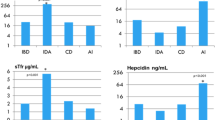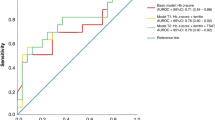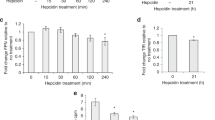Abstract
Background:
The diagnostic use of hepcidin is limited by the absence of standardization and lack of age-specific reference ranges in children in particular. The aim of this study was to determine reference ranges of serum hepcidin in healthy children aged 0.5–3 y using mass spectometry (MS) and a commercial immunochemical (IC) assay, and to investigate its association with other indicators of iron status and inflammation.
Methods:
We included 400 healthy children aged 0.5–3 y. We constructed reference ranges for MS-hepcidin and IC-hepcidin concentrations using the median, P2.5, and P97.5 in a normative population of 219 children with no anemia, no infection and/or inflammation, and no iron deficiency.
Results:
Median concentrations (P2.5–P97.5) of MS-hepcidin and IC-hepcidin were 3.6 nmol/l (0.6–13.9 nmol/l) and 7.9 nmol/l (1.9–28.6 nmol/l), respectively. We found a good correlation between both methods. However, MS-hepcidin was consistently lower than IC-hepcidin. Hepcidin correlated with ferritin and C-reactive protein.
Conclusion:
We provide reference ranges for hepcidin for an MS and commercial IC method. Absolute values between assays differed significantly, but hepcidin concentrations obtained by MS and IC methods correlate with each other, and both correlate with ferritin and CRP.
Similar content being viewed by others
Log in or create a free account to read this content
Gain free access to this article, as well as selected content from this journal and more on nature.com
or
References
Nemeth E, Ganz T . The role of hepcidin in iron metabolism. Acta Haematol 2009;122:78–86.
Kroot JJ, Tjalsma H, Fleming RE, Swinkels DW . Hepcidin in human iron disorders: diagnostic implications. Clin Chem 2011;57:1650–69.
Ganz T, Nemeth E . Regulation of iron acquisition and iron distribution in mammals. Biochim Biophys Acta 2006;1763:690–9.
Pak M, Lopez MA, Gabayan V, Ganz T, Rivera S . Suppression of hepcidin during anemia requires erythropoietic activity. Blood 2006;108:3730–5.
Ganz T, Nemeth E . Iron sequestration and anemia of inflammation. Semin Hematol 2009;46:387–93.
Weiss G, Goodnough LT . Anemia of chronic disease. N Engl J Med 2005;352:1011–23.
Müller KF, Lorenz L, Poets CF, Westerman M, Franz AR . Hepcidin concentrations in serum and urine correlate with iron homeostasis in preterm infants. J Pediatr 2012;160:949–53.e2.
Berglund S, Lönnerdal B, Westrup B, Domellöf M . Effects of iron supplementation on serum hepcidin and serum erythropoietin in low-birth-weight infants. Am J Clin Nutr 2011;94:1553–61.
de Mast Q, Syafruddin D, Keijmel S, et al. Increased serum hepcidin and alterations in blood iron parameters associated with asymptomatic P. falciparum and P. vivax malaria. Haematologica 2010;95:1068–74.
Jaeggi T, Moretti D, Kvalsvig J, et al. Iron status and systemic inflammation, but not gut inflammation, strongly predict gender-specific concentrations of serum hepcidin in infants in rural Kenya. PLoS ONE 2013;8:e57513.
Semrin G, Fishman DS, Bousvaros A, et al. Impaired intestinal iron absorption in Crohn’s disease correlates with disease activity and markers of inflammation. Inflamm Bowel Dis 2006;12:1101–6.
del Giudice EM, Santoro N, Amato A, et al. Hepcidin in obese children as a potential mediator of the association between obesity and iron deficiency. J Clin Endocrinol Metab 2009;94:5102–7.
Choi HS, Song SH, Lee JH, Kim HJ, Yang HR . Serum hepcidin levels and iron parameters in children with iron deficiency. Korean J Hematol 2012;47:286–92.
Cangemi G, Pistorio A, Miano M, et al. Diagnostic potential of hepcidin testing in pediatrics. Eur J Haematol 2013;90:323–30.
Schaap CC, Hendriks JC, Kortman GA, et al. Diurnal rhythm rather than dietary iron mediates daily hepcidin variations. Clin Chem 2013;59:527–35.
Kroot JJ, Kemna EH, Bansal SS, et al. Results of the first international round robin for the quantification of urinary and plasma hepcidin assays: need for standardization. Haematologica 2009;94:1748–52.
Berglund SK, Westrup B, Hägglöf B, Hernell O, Domellöf M . Effects of iron supplementation of LBW infants on cognition and behavior at 3 years. Pediatrics 2013;131:47–55.
Galesloot TE, Vermeulen SH, Geurts-Moespot AJ, et al. Serum hepcidin: reference ranges and biochemical correlates in the general population. Blood 2011;117:e218–25.
Kroot JJ, van Herwaarden AE, Tjalsma H, Jansen RT, Hendriks JC, Swinkels DW . Second round robin for plasma hepcidin methods: first steps toward harmonization. Am J Hematol 2012;87:977–83.
Hunter HN, Fulton DB, Ganz T, Vogel HJ . The solution structure of human hepcidin, a peptide hormone with antimicrobial activity that is involved in iron uptake and hereditary hemochromatosis. J Biol Chem 2002;277:37597–603.
Jordan JB, Poppe L, Haniu M, et al. Hepcidin revisited, disulfide connectivity, dynamics, and structure. J Biol Chem 2009;284:24155–67.
Laarakkers CM, Wiegerinck ET, Klaver S, et al. Improved mass spectrometry assay for plasma hepcidin: detection and characterization of a novel hepcidin isoform. PLoS ONE 2013;8:e75518.
Sherriff A, Emond A, Hawkins N, Golding J . Haemoglobin and ferritin concentrations in children aged 12 and 18 months. ALSPAC Children in Focus Study Team. Arch Dis Child 1999;80:153–7.
Looker AC, Dallman PR, Carroll MD, Gunter EW, Johnson CL . Prevalence of iron deficiency in the United States. JAMA 1997;277:973–6.
Uijterschout L, Vloemans J, Vos R, et al. Prevalence and risk factors of iron deficiency in healthy young children in the southwestern Netherlands. J Pediatr Gastroenterol Nutr 2014;58:195–200.
Mast AE, Blinder MA, Dietzen DJ . Reticulocyte hemoglobin content. Am J Hematol 2008;83:307–10.
Fredriks AM, van Buuren S, Burgmeijer RJ, et al. Continuing positive secular growth change in The Netherlands 1955-1997. Pediatr Res 2000;47:316–23.
Knol FA . From high to low; from low to high [in Dutch], 2012. (http://www.scp.nl/Publicaties/Alle_publicaties/Publicaties_2012/Statusontwikkeling_van_wijken_in_Nederland_1998_2010.)
World Health Organization. Assessing the iron status of populations, 2007. (http://www.who.int/nutrition/publications/micronutrients/anaemia_iron_deficiency/9789241596107/en/.)
Kroot JJ, Laarakkers CM, Geurts-Moespot AJ, et al. Immunochemical and mass-spectrometry-based serum hepcidin assays for iron metabolism disorders. Clin Chem 2010;56:1570–9.
Ganz T, Olbina G, Girelli D, Nemeth E, Westerman M . Immunoassay for human serum hepcidin. Blood 2008;112:4292–7.
Van den Bruel A, Thompson MJ, Haj-Hassan T, et al. Diagnostic value of laboratory tests in identifying serious infections in febrile children: systematic review. BMJ 2011;342:d3082.
Author information
Authors and Affiliations
Corresponding author
Supplementary information
Supplementary Figure S1
(TIFF 6991 kb)
Supplementary Tables
(DOC 64 kb)
PowerPoint slides
Rights and permissions
About this article
Cite this article
Uijterschout, L., Swinkels, D., Domellöf, M. et al. Serum hepcidin measured by immunochemical and mass-spectrometric methods and their correlation with iron status indicators in healthy children aged 0.5–3 y. Pediatr Res 76, 409–414 (2014). https://doi.org/10.1038/pr.2014.109
Received:
Accepted:
Published:
Issue date:
DOI: https://doi.org/10.1038/pr.2014.109
This article is cited by
-
Hepcidin is a relevant iron status indicator in infancy: results from a randomized trial of early vs. delayed cord clamping
Pediatric Research (2021)
-
Hepcidin and other indicators of iron status, by alpha-1 acid glycoprotein levels, in a cohort of Mexican infants
Annals of Hematology (2021)
-
Importance of Hepcidin in the Etiopathogenesis of Anemia in Inflammatory Bowel Disease
Digestive Diseases and Sciences (2021)
-
Hepcidin mediates hypoferremia and reduces the growth potential of bacteria in the immediate post-natal period in human neonates
Scientific Reports (2019)
-
Serum hepcidin levels, iron status, and HFE gene alterations during the first year of life in healthy Spanish infants
Annals of Hematology (2018)



